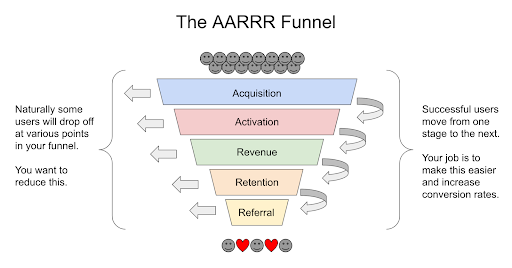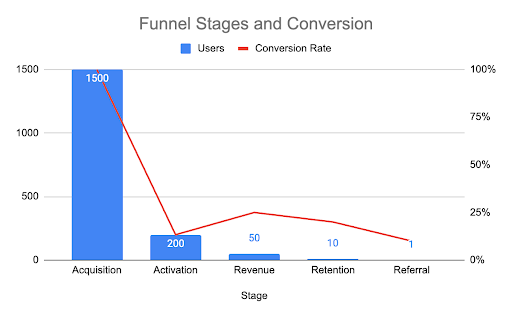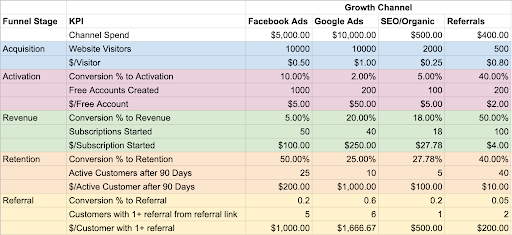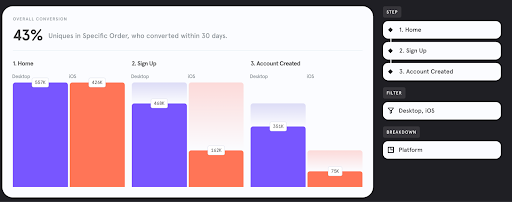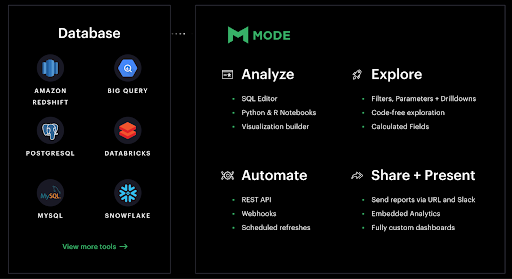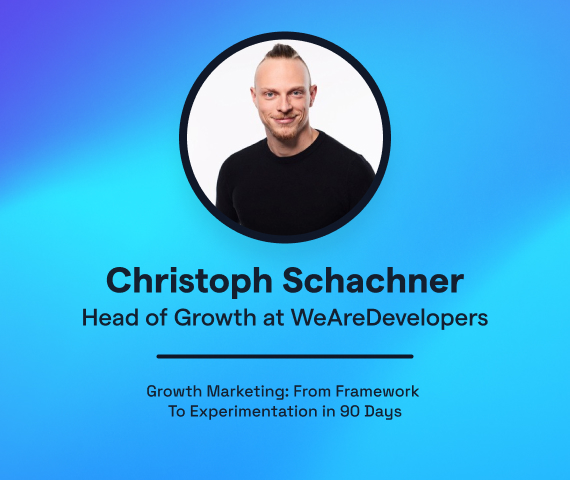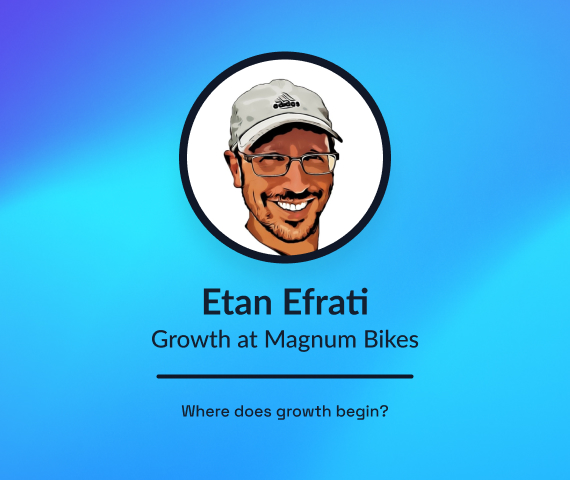Using funnel analysis to optimize growth
So you’re a marketer or product manager looking to grow your business – welcome to the group! It’s exciting to think about all the different ways you could go about accomplishing that goal, from splashy superbowl ads to a perfectly designed product experience that people love to use, but figuring out where to spend your time and money can be daunting, especially when they are in short supply.
On your journey to repeatable, scalable growth, you’ll constantly be dealing with questions like:
- “Which marketing channel should we put more money into and which should we cut back on?”
- “How much did that last campaign we launched generate in revenue for us?”
- “Which feature should our development team work on next to increase our growth most?”
- “Which customers is our product resonating with and how do we find more like them?”
If you can already answer these types of questions with the proof to back up your claims, you’re in great shape. If you can’t, however, then one of the most useful ways to find those answers so that you can confidently push forward with your growth strategy, is by analyzing your user funnel.
What is a Funnel and why does it matter?
To generate growth, new people need to be able to learn about your product, opt in to using it, and then successfully use its features to meet their needs repeatedly. While this may sound simple at a high level, the reality is that to be successful, your users will likely need to go through many steps, across many surfaces, and a lot of those people will fail or lose interest along the way. With so many variables at play, it can be difficult to get a clear picture of where to look, which is where the funnel comes in.

Nick SchwinghamerA funnel gives you a logical way to track and analyze the performance of key stages of your user journey so you can determine what’s working and what’s not, allowing you to prioritize efforts on things that have the greatest chance of driving growth. It helps you turn data into insight, and insight into action.
Leveraging a well crafted funnel can be a critical part of refining your growth strategy, with a few main benefits.
1. Simplify success tracking
Often, people thinking about growth are buried in KPIs (clickthrough rate, leads generated, signups, churn, revenue, lifetime value, $/lead, clicks, usage rate of a certain feature, bounce rate, impressions, etc etc etc). The problem is, with so many to look at it’s hard to know which KPIs really matter and are core to the success of the business. By creating a funnel that captures the most important stages in your customer journey, you’ll reduce the number of metrics you need to look at to diagnose growth opportunities and the success of your efforts at a high level, allowing you to dive into more details only as needed.
2. Effectively prioritize your work
Using the funnel, you’ll be able to spot which parts of the journey users are getting stuck on, and use that as a jumping off point to learn more about why they’re having trouble in order to help them overcome those stages. You’ll be able to determine things like which marketing channels have the biggest impact on your bottom line or which segment of users your product is a best fit for, and which are struggling, among an endless list of insights you can glean.
Armed with these insights, you’ll be able to confidently build a set of hypotheses and a corresponding roadmap of high-impact tests to supercharge your growth, with a way to measure the results on the business success going forward.
3. Improve your internal alignment
When it’s clear what KPIs matter to drive growth and they are properly tracked using a funnel, it becomes much easier to communicate the problems and opportunities you’re seeing in the marketing or product experience to your team. Whether you’re trying to provide insight to the executive team on your strategic direction, trying to get approval from finance to increase marketing spend or working with the development team to prioritize features for the next sprint, you’ll be more likely to succeed using a simple, logical framework that’s easy for others to understand and use themselves.
Building a funnel
Once you’ve decided you’d like to get started with funnel analysis, you’ll need to decide what will be included in yours.

Nick SchwinghamerThere is no definitively correct way to design a funnel that will apply to all businesses, but as a general rule, simple is better than perfect.
When you are starting out with funnel analysis, you may be tempted to make sure it’s juuuuuuust right and gives you everything you’ll ever need so you can do it once and be done. I’d advise you to take the MVP approach with your funnel, however, keeping it relatively high level and simple to begin with. This will make it easier to understand and faster to implement, and can always be expanded upon as you figure out how you’ll use it and how to get the insight you really care about. A funnel is a great resource, but it’s just one tool of many you’ll use to plan your growth strategy and won’t answer everything.
A Framework for funnel design – Pirate Metrics (AARRR)
One of my favorite frameworks to lean on when designing a funnel is Pirate Metrics (for the acronym of steps involved – AARRR), a concept shared by Dave McClure in his 2007 presentation called “Startup Metrics for Pirates”.
Pirate metrics outlines 5 key funnel stages as Acquisition, Activation, Revenue, Retention and Referral. The order of these stages might change depending on how your business works, but the underlying concepts are the same and your goal is to help customers convert as effectively as possible from one stage to the next.
For each stage, you’ll need to identify 1-2 KPIs that will be used to measure whether users have reached that stage in the user journey, and each will have a different set of tactics you can use to improve your growth.
1. Acquisition – Are people finding your business?
For almost all businesses, acquisition is the first step in the funnel. This stage is all about getting people to understand your products or business exist, and intriguing them enough to get them to visit you.
Example KPIs:
- # people who have visited your website
- # people who have visited your retail store
Example Tactics to Improve Acquisition:
- Advertise on ad networks (google, fb, etc)
- Share content you create (reddit, forums, instagram, tik tok etc)
- Partner with companies that have a relevant audience (integrations, apps, content)
- Improve your SEO so you show up when people search for relevant terms
- Buy TV commercials or billboards
- Sponsor events
2. Activation – Are people engaging with your product/service?
In the activation stage, you want people to take some sort of action to indicate they are interested in what you have to offer. Many times, by the time this stage is complete, you’ll have some key information from the user, like their email address.
Example KPIs:
- # people signed up to your free email list
- # people created a free trial account
- # people who have downloaded your app
- # people that hit some milestone while using the free version of your product
- # people that have added something to their cart
Example Tactics to Improve Activation:
- Landing Page optimization (speed and content)
- Retargeting ads on ad networks like google, facebook and instagram
- Prompts for email collection (“join our newsletter for X% off”, “enter your email to win”, etc.)
- Signup form optimization
3. Revenue – Are people willing to pay for your product/service?
The revenue stage is the critical step where potential customers turn into real customers and pay you for what you have to offer. At this stage, they are convinced your product meets their needs and are willing to give you their payment info, either for a single purchase or a subscription.
Example KPIs:
- # of people making their first purchase
- # of people signing up for a monthly subscription
Example Tactics to Improve Revenue:
- Product Page optimization (videos, images, copy, reviews)
- Social proof (positive reviews, big names using your product etc)
- Free Shipping
- Email Newsletter Campaigns
- Limited Time/Quantity offers
- Generous/easy return or cancellation policies
- Free Trials that automatically convert to paid subscriptions at end of the trial
4. Retention – Are people coming back for more?
Users that keep coming back to your products again and again, whether that means buying more from you, or actively using your solution to accomplish their goals is what retention is all about. In order for this to be true, your users will have had good initial experiences with your products, and are willing to keep using it to do so. Like many of the other funnel stages, the meaning of retention can be very flexible depending on what repeat usage/purchases look like for your type of business.
Example KPIs:
- # customers making a repeat purchase
- # users actively using product after X days (30, 60, 90….)
Example Tactics to Improve Retention:
- Customer training/education on how to be successful using your product
- Transactional Email/SMS/App notification triggers for key activity like messages from others, actions to complete etc.
- Account managers for high profile customers
- Making your product easier to use/adding new features your customers want
- Discount codes for future purchases
- Seasonal events/sales/product releases
- Community building (events, online groups, etc)
- Strong customer support experience
5. Referral – Are people telling others about you?
Finally, there is the referral stage. Once you’ve provided enough value to your users, they may be compelled to share your business/product with their networks as a recommendation. Referrals are a powerful way to drive highly qualified new users to your business or convert ones that are already aware of what you offer because word of mouth from happy customers is very different than marketing direct from a company. To get to this stage though, your users will often need to be really impressed with what you have to offer.
Example KPIs:
- # new users from referral sources (whether the new user indicates they were referred by someone as part of signup form data collection, or based on unique referral links that are shared by referring users)
- # people creating a unique referral link to share (like an affiliate program)
- # of people sharing your links on social media
Example Tactics to Improve Referrals:
- Post-purchase email/card in the package asking them to refer
- Post-positive-review message asking them to refer
- Referral bonus offer (ex: extra product benefits for every referral – like dropbox offering more free space for each referral, $ for every successful referral, etc)
Example Funnels By Industry
Now that you have a good understanding of the key components and stages of funnels in general, here are some ideas on what basic funnels might look like depending on what type of product/service you’re offering. For each of the following metrics listed, in a funnel you’ll want to track the # of users that achieve that step, not the number of times they do each.
Analyzing Your Funnel For Insights
Once you have your funnel defined and are tracking the data, you’ll be able to start taking a look at it to understand where you have opportunities to improve. While every business is different, you’ll want to keep a few things in mind to prioritize work based on your funnel data.
1. Look for Industry Benchmarks To Guide You
For most industries you’ll be able to find some comparable benchmarks for expected conversion rate data. The more specific the comparison data is to your niche the better (ie, not just ecommerce, but fashion stores or electronics stores), and below I’ve included links to a few benchmark reports you might want to use as a starting point. If you understand what type of conversion rates other companies are seeing, it can give you a pretty good idea of how far you might be able to go in improving your own efforts. There is likely a big difference in the potential returns on your effort if you are 50% below industry average conversion rates, than if you’re 5% above.
Example conversion rate benchmarks can be found here:
- Ecommerce Conversion Rates by Industry – Hubspot
- SaaS Marketing Funnel Conversion Rate Benchmarks – Growfusely
- B2B SaaS Funnel Conversion Benchmarks – Stijn Hendrikse
- What’s a Good App Conversion Rate for an App Store Page? – Splitmetrics
2. Generally Prioritize Deeper Funnel Stages First
When choosing which stage of your funnel to optimize first, the reality is that when you look at it from a math perspective, where you start to optimize doesn’t matter to the overall conversion rate. Increasing your Activation stage conversion by 10% will have the same overall impact on conversion rate as if you increase the Revenue stage by 10%.
That being said, making sure you can actually convert the visitors you’re getting into paying customers with a smaller top of funnel group at the acquisition stage (ie focusing on activation and revenue stages first), will mean you don’t waste a lot of marketing dollars driving traffic to your business to just have it bounce or drop off right away. It’ll also mean that by the time you DO get around to optimizing the acquisition stage, you’ll be able to more confidently drive people deeper into your funnel, allowing you to scale faster and more cost efficiently.
3. Look for Big Drop Offs in You Funnel
When looking at your funnel, you’ll likely have the biggest returns if you’re able to focus on improving the areas where your conversion is worst. In many cases, it’s easier to have a huge impact on your overall funnel if you focus on optimizing a stage that only has 5% conversion, than one that’s already at 50% conversion.
4. Get More Granular with Your Funnel Over Time
Earlier, I mentioned that it’s best to get a basic version of your funnel setup and running fast, instead of worrying about getting it perfect right off the bat. Once you do have that basic funnel running and you start to spot some areas you’d like to learn more about or focus on improving, however, you may find you need more data to really understand what’s going on – that’s a good signal it’s time to add some more granular steps and data points to your funnel to further break things down and unlock growth.
As an example, in the basic SaaS funnel outlined above, the steps are Visit Website -> Sign up to free account when going from acquisition to activation. If you find that conversion rate is really low, you may want to dig into your signup flow and have funnel stages like:
- Visit Website
- Signup to Free account
- Click Signup Button
- Complete signup form page 1
- Complete signup form page 2
- Confirm account creation via email authentication
By concentrating on building out your funnel slowly, and focusing on the areas where you think there is the biggest chance to improve, you minimize wasted time and energy and are constantly unlocking new levels of insight and associated actions as you go.
Segmenting your funnel for more insights
Aside from looking at just your high-level funnel, you can gain a ton of insight by segmenting the way you’re looking at the data, giving you new angles to approach optimization and experimentation.
Segmenting by growth channel/campaign
For all the marketers out there, this approach to using your funnel is critical to your understanding of how your efforts are impacting your growth.
In this method, you split your data up and analyze how different sources of traffic are driving your customers through your funnel – whether that means looking at it based on marketing channel (ie facebook ads vs google ads vs SEO etc) or on a campaign basis (ie back to school campaign, superbowl promo, summer sale etc).
This way of looking at your data is super powerful for a few reasons.
- You can see which channels are driving the best growth for your business. You don’t want to keep investing in channels/campaigns that aren’t providing any returns, or in channels that drive a lot of traffic, but don’t turn into real paying customers down the line. This gives you a solid, analytical method to compare those efforts and make objective decisions.
- You can understand how much user actions are worth. Breaking user behavior down into stages shows you how much you’re paying for users at each part of the funnel, allowing you to better estimate future budgets and make smart allocation decisions as you’re trying to hit specific growth targets.
- It drives alignment between marketing and product teams. If you notice, for example, that people who come from facebook ads are converting at a much lower rate than other channels, you can build experiments that target those specific sources of traffic to increase conversion (think custom landing pages, signup flows, offers etc). This can supercharge your marketing efforts, and allow you to really hone in on optimizing the experience for all the traffic being driven to your business.
Segmenting by user group
Another useful way to break down your funnel is looking at how customers from different segments convert from one stage to another. Depending on your business, the segments you choose could be virtually anything, but some common ways to segment your users include:
- By country/language
- By Spend/monthly plan
- By Product Purchased
Segmenting by time
Finally, one thing to keep in mind as you’re optimizing your funnel, is that its performance will change over time. Generally, you’ll want to bucket your data into cohorts of users so you can see if you’re improving things or making them worse with the experiments you launch. A good format for this to get started, is to start tracking this on a monthly basis.
Determining the ‘why’ your funnel’s ‘where’
While your funnel will be great at helping you determine where in the customer journey you might want to optimize, it won’t give you the details on why it’s currently not performing as well as you’d like. To get to that insight, you’ll need to pair your funnel knowledge with other tools that will help you create hypotheses to test and prioritize your backlog of great ideas.
To understand the issues blocking your growth, your best bet is to go direct to the source – your users. You can get an incredible level of insight into how to improve your product by listening to and watching users through countless user research tools and approaches, including some of my favorites:
- User Interviews – talk to users directly about the product and their experiences with it.
- Mining Support Teams – your support team is constantly helping people use the product more effectively and sure has a good pulse on the most common issues people are experiencing.
- Watch People Use The Product – actions often speak louder than words, and watching a new user interact with your product in real time can be an illuminating experience.
For more details on the best ways to conduct user research, I’d suggest taking a look at this guide from UserTesting.com.
Tools for funnel tracking
At this point, you’re probably wondering how to get started in actually implementing your very own funnel tracking. To make that easier, there are numerous tools out there that can help you achieve this goal. You can choose to use basic, off-the-shelf type of tools that will be easy to implement, or you can go with more powerful tools that give you full control over your reporting and event tracking, but as always, remember that getting something going is better than nothing at all, and you can always improve it in the future.
Spreadsheets (use this bonus template!)
One of the most powerful, lightweight and flexible ways to organize and track your data will be through the good old spreadsheet. The massive benefit of this approach is being able to pull data from multiple sources and combine it in one central place that doesn’t take any specialized programming skills to modify. Even in conjunction with the more advanced tools listed below, you’ll probably end up using spreadsheets in some form or another.
To make it easy to get started, you can make a copy of the template I’ve created and used in the examples of the analysis section above.
Get your Basic Funnel Tracking Spreadsheet Template here.
In it, you’ll find a starter template for monthly funnel tracking, tracking your marketing efforts through the funnel by channel or campaign, and a template to track different segments of your audience through the funnel as well.
Google Analytics
One of the most commonly used tools out there for tracking metrics across your website, Google Analytics is a great choice as an entry-level solution to funnel tracking. You’re able to install it quickly, and create custom events and reports that will show you how your funnel is doing.
If you’re looking for specifics on how to get it setup, checkout this great explainer from Neil Patel – The Google Analytics Conversion Funnel Survival Guide.
Mixpanel
If you’re looking for a tool that’s a little more advanced, I’d suggest taking a look at analytics company Mixpanel.
To get tracking working properly, you’ll need to do some more setup work than with google analytics, and your ability to get deep insights will really be supercharged if you have the skills or help from a developer. The benefit of this tool is a lot more customization over the way the data is gathered and reported, including options quickly filter and segment your user funnels.
Mode
If you’re a bigger organization with some dedicated data science team members, then going to a more advanced solution like Mode will give you full control over the way your data is collected and visualized with powerful, enterprise level tools.
It requires a lot of technical knowledge to use, but can be the right solution for teams that have large existing data stores they’d like to visualize, or want to do things that are really advanced.
Listen to the episode that inspired this blog post:
Wrap up
As you’ve now seen, tracking your funnel can provide an incredible amount of value to any business looking to grow. From simplifying focus, aligning teams with a consistent mental model and way to track success, to helping prioritize work to reach maximum impact based on factors that are specific to your business, it truly is one of the most important and versatile tools in the growth tool belt.
As you gain insight, and help your users experience the value your products provide, they are inevitably going to get stuck along the way. With the customer funnel, you’ll be well equipped to systematically help them get un-stuck, reducing friction, improving their experiences and seeing your business benefit as a result.
If you don’t yet have a funnel setup for your business, what are you waiting for?!



